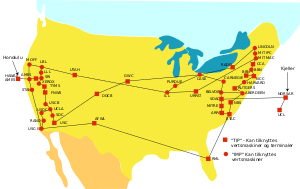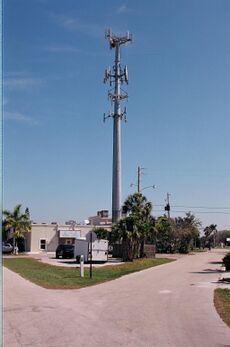هندسة الاتصالات
هندسة الاتصالات هي الهندسة التي تتعلق بكل مواضيع الاتصالات الرقمية والتناظرية. وهي تشمل ضمن طياتها الشارات الكهربائية والكهرومغناطيسية، وطرق انتقالها، ومعالجتها.
نظام الاتصال يتكون عادة من مرسل ومستقبل وقناة اتصال. هندسة الاتصالات تدرس هذه المكونات الثلاثة بالتفصيل:
- المرسل: هو الوحدة التي تقوم باخذ المعلومات وتحضيرها لترسل عبر القناة، وهنا يحدث التضمين (modulation).
- القناة: وهو الوسط الذي تنتقل فيه الإشارات والمعلوماتيه (مثل الجو في حالة الإذاعة).
- المستقبل: وهو وحدة الاستقبال للإشارات، وفيها تتم ازالة المعالجة للإشارات واظهارها بشكل معلومات من جديد.
. . . . . . . . . . . . . . . . . . . . . . . . . . . . . . . . . . . . . . . . . . . . . . . . . . . . . . . . . . . . . . . . . . . . . . . . . . . . . . . . . . . . . . . . . . . . . . . . . . . . . . . . . . . . . . . . . . . . . . . . . . . . . . . . . . . . . . . . . . . . . . . . . . . . . . . . . . . . . . . . . . . . . . . .
التاريخ
Telecommunication systems are generally designed by telecommunication engineers which sprang from technological improvements in the telegraph industry in the late 19th century and the radio and the telephone industries in the early 20th century. Today, telecommunication is widespread and devices that assist the process, such as the television, radio and telephone, are common in many parts of the world. There are also many networks that connect these devices, including computer networks, public switched telephone network (PSTN),[بحاجة لمصدر] radio networks, and television networks. Computer communication across the Internet is one of many examples of telecommunication.[بحاجة لمصدر] Telecommunication plays a vital role in the world economy, and the telecommunication industry's revenue has been placed at just under 3% of the gross world product.[بحاجة لمصدر]
التلغراف والهاتف
Samuel Morse independently developed a version of the electrical telegraph that he unsuccessfully demonstrated on 2 September 1837. Soon after he was joined by Alfred Vail who developed the register — a telegraph terminal that integrated a logging device for recording messages to paper tape. This was demonstrated successfully over three miles (five kilometres) on 6 January 1838 and eventually over forty miles (sixty-four kilometres) between Washington, D.C. and Baltimore on 24 May 1844. The patented invention proved lucrative and by 1851 telegraph lines in the United States spanned over 20,000 miles (32,000 kilometres).[1]
The first successful transatlantic telegraph cable was completed on 27 July 1866, allowing transatlantic telecommunication for the first time. Earlier transatlantic cables installed in 1857 and 1858 only operated for a few days or weeks before they failed.[2] The international use of the telegraph has sometimes been dubbed the "Victorian Internet".[3]
The first commercial telephone services were set up in 1878 and 1879 on both sides of the Atlantic in the cities of New Haven and London. Alexander Graham Bell held the master patent for the telephone that was needed for such services in both countries. The technology grew quickly from this point, with inter-city lines being built and telephone exchanges in every major city of the United States by the mid-1880s.[4][5][6] Despite this, transatlantic voice communication remained impossible for customers until January 7, 1927, when a connection was established using radio. However no cable connection existed until TAT-1 was inaugurated on September 25, 1956, providing 36 telephone circuits.[7]
In 1880, Bell and co-inventor Charles Sumner Tainter conducted the world's first wireless telephone call via modulated lightbeams projected by photophones. The scientific principles of their invention would not be utilized for several decades, when they were first deployed in military and fiber-optic communications.
الراديو والتلفزيون
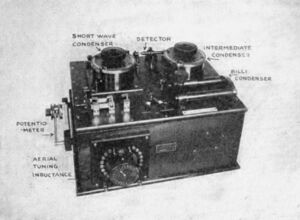
Over several years starting in 1894, the Italian inventor Guglielmo Marconi built the first complete, commercially successful wireless telegraphy system based on airborne electromagnetic waves (radio transmission).[8] In December 1901, he would go on to established wireless communication between Britain and Newfoundland, earning him the Nobel Prize in physics in 1909 (which he shared with Karl Braun).[9] In 1900, Reginald Fessenden was able to wirelessly transmit a human voice. On March 25, 1925, Scottish inventor John Logie Baird publicly demonstrated the transmission of moving silhouette pictures at the London department store Selfridges. In October 1925, Baird was successful in obtaining moving pictures with halftone shades, which were by most accounts the first true television pictures.[10] This led to a public demonstration of the improved device on 26 January 1926 again at Selfridges. Baird's first devices relied upon the Nipkow disk and thus became known as the mechanical television. It formed the basis of semi-experimental broadcasts done by the British Broadcasting Corporation beginning September 30, 1929.
الساتل
The first U.S. satellite to relay communications was Project SCORE in 1958, which used a tape recorder to store and forward voice messages. It was used to send a Christmas greeting to the world from U.S. President Dwight D. Eisenhower. In 1960 NASA launched an Echo satellite; the 100-foot (30 m) aluminized PET film balloon served as a passive reflector for radio communications. Courier 1B, built by Philco, also launched in 1960, was the world's first active repeater satellite. Satellites these days are used for many applications such as uses in GPS, television, internet and telephone uses.
Telstar was the first active, direct relay commercial communications satellite. Belonging to AT&T as part of a multi-national agreement between AT&T, Bell Telephone Laboratories, NASA, the British General Post Office, and the French National PTT (Post Office) to develop satellite communications, it was launched by NASA from Cape Canaveral on July 10, 1962, the first privately sponsored space launch. Relay 1 was launched on December 13, 1962, and became the first satellite to broadcast across the Pacific on November 22, 1963.[11]
The first and historically most important application for communication satellites was in intercontinental long distance telephony. The fixed Public Switched Telephone Network relays telephone calls from land line telephones to an earth station, where they are then transmitted a receiving satellite dish via a geostationary satellite in Earth orbit. Improvements in submarine communications cables, through the use of fiber-optics, caused some decline in the use of satellites for fixed telephony in the late 20th century, but they still exclusively service remote islands such as Ascension Island, Saint Helena, Diego Garcia, and Easter Island, where no submarine cables are in service. There are also some continents and some regions of countries where landline telecommunications are rare to nonexistent, for example Antarctica, plus large regions of Australia, South America, Africa, Northern Canada, China, Russia and Greenland.
After commercial long distance telephone service was established via communication satellites, a host of other commercial telecommunications were also adapted to similar satellites starting in 1979, including mobile satellite phones, satellite radio, satellite television and satellite Internet access. The earliest adaption for most such services occurred in the 1990s as the pricing for commercial satellite transponder channels continued to drop significantly.
Computer networks and the Internet
On 11 September 1940, George Stibitz was able to transmit problems using teleprinter to his Complex Number Calculator in New York and receive the computed results back at Dartmouth College in New Hampshire.[12] This configuration of a centralized computer or mainframe computer with remote "dumb terminals" remained popular throughout the 1950s and into the 1960s. However, it was not until the 1960s that researchers started to investigate packet switching — a technology that allows chunks of data to be sent between different computers without first passing through a centralized mainframe. A four-node network emerged on 5 December 1969. This network soon became the ARPANET, which by 1981 would consist of 213 nodes.[13]
ARPANET's development centered around the Request for Comment process and on 7 April 1969, RFC 1 was published. This process is important because ARPANET would eventually merge with other networks to form the Internet, and many of the communication protocols that the Internet relies upon today were specified through the Request for Comment process. In September 1981, RFC 791 introduced the Internet Protocol version 4 (IPv4) and RFC 793 introduced the Transmission Control Protocol (TCP) — thus creating the TCP/IP protocol that much of the Internet relies upon today.
Optical fiber
Optical fiber can be used as a medium for telecommunication and computer networking because it is flexible and can be bundled into cables. It is especially advantageous for long-distance communications, because light propagates through the fiber with little attenuation compared to electrical cables. This allows long distances to be spanned with few repeaters.
In 1966 Charles K. Kao and George Hockham proposed optical fibers at STC Laboratories (STL) at Harlow, England, when they showed that the losses of 1000 dB/km in existing glass (compared to 5-10 dB/km in coaxial cable) was due to contaminants, which could potentially be removed.
Optical fiber was successfully developed in 1970 by Corning Glass Works, with attenuation low enough for communication purposes (about 20dB/km), and at the same time GaAs (Gallium arsenide) semiconductor lasers were developed that were compact and therefore suitable for transmitting light through fiber optic cables for long distances.
After a period of research starting from 1975, the first commercial fiber-optic communications system was developed, which operated at a wavelength around 0.8 μm and used GaAs semiconductor lasers. This first-generation system operated at a bit rate of 45 Mbps with repeater spacing of up to 10 km. Soon on 22 April 1977, General Telephone and Electronics sent the first live telephone traffic through fiber optics at a 6 Mbit/s throughput in Long Beach, California.
The first wide area network fibre optic cable system in the world seems to have been installed by Rediffusion in Hastings, East Sussex, UK in 1978. The cables were placed in ducting throughout the town, and had over 1000 subscribers. They were used at that time for the transmission of television channels, not available because of local reception problems.
The first transatlantic telephone cable to use optical fiber was TAT-8, based on Desurvire optimized laser amplification technology. It went into operation in 1988.
In the late 1990s through 2000, industry promoters, and research companies such as KMI, and RHK predicted massive increases in demand for communications bandwidth due to increased use of the Internet, and commercialization of various bandwidth-intensive consumer services, such as video on demand, Internet Protocol data traffic was increasing exponentially, at a faster rate than integrated circuit complexity had increased under Moore's Law.[14]
. . . . . . . . . . . . . . . . . . . . . . . . . . . . . . . . . . . . . . . . . . . . . . . . . . . . . . . . . . . . . . . . . . . . . . . . . . . . . . . . . . . . . . . . . . . . . . . . . . . . . . . . . . . . . . . . . . . . . . . . . . . . . . . . . . . . . . . . . . . . . . . . . . . . . . . . . . . . . . . . . . . . . . . .
المفاهيم
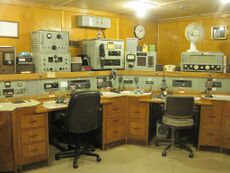
Basic elements of a telecommunication system
Transmitter
Transmitter (information source) that takes information and converts it to a signal for transmission. In electronics and telecommunications a transmitter or radio transmitter is an electronic device which, with the aid of an antenna, produces radio waves. In addition to their use in broadcasting, transmitters are necessary component parts of many electronic devices that communicate by radio, such as cell phones,
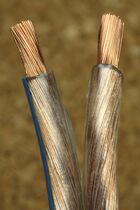
Transmission medium
Transmission medium over which the signal is transmitted. For example, the transmission medium for sounds is usually air, but solids and liquids may also act as transmission media for sound. Many transmission media are used as communications channel. One of the most common physical medias used in networking is copper wire. Copper wire is used to carry signals to long distances using relatively low amounts of power. Another example of a physical medium is optical fiber, which has emerged as the most commonly used transmission medium for long-distance communications. Optical fiber is a thin strand of glass that guides light along its length.
The absence of a material medium in vacuum may also constitute a transmission medium for electromagnetic waves such as light and radio waves.
Receiver
Receiver (information sink) that receives and converts the signal back into required information. In radio communications, a radio receiver is an electronic device that receives radio waves and converts the information carried by them to a usable form. It is used with an antenna. The information produced by the receiver may be in the form of sound (an audio signal), images (a video signal) or digital data.[15]
Wired communication
Wired communications make use of underground communications cables (less often, overhead lines), electronic signal amplifiers (repeaters) inserted into connecting cables at specified points, and terminal apparatus of various types, depending on the type of wired communications used.[16]
Wireless communication
Wireless communication involves the transmission of information over a distance without help of wires, cables or any other forms of electrical conductors.[17] Wireless operations permit services, such as long-range communications, that are impossible or impractical to implement with the use of wires. The term is commonly used in the telecommunications industry to refer to telecommunications systems (e.g. radio transmitters and receivers, remote controls etc.) which use some form of energy (e.g. radio waves, acoustic energy, etc.) to transfer information without the use of wires.[18] Information is transferred in this manner over both short and long distances.[بحاجة لمصدر]
الاتصالات ومجالات الهندسة
تتداخل هندسة الاتصالات في الهندسة مع فروع عديدة أبرزها الهندسة الالكترونية ويمتد نطاق هذا المجال من تصميم الدوائر الأساسية إلي التطورات الإستراتيجية الشاملة. مهندس الاتصالات هو المسئول عن تصميم معدات الاتصالات السلكية واللاسلكية والمرافق والإشراف على تركيبها، مثل مجمع نظم التحويل الإلكتروني، ومرافق الهاتف النحاسية والألياف البصرية. هندسة الاتصالات تتداخل أيضا بشكل كبير مع الهندسة الإذاعية.
الاتصالات السلكية واللاسلكية هي مجال هندسي متنوع يشمل الهندسة الالكترونية والمدنية والهيكلية، والهندسة الكهربائية فضلا عن كونها سفيرا سياسيا واجتماعيا، وتشمل قليلا من المحاسبة والكثير من إدارة المشروعات. لذا جوهريا مهندسو الاتصالات مسئولون عن توفير الطريقة المناسبة للعملاء للحصول على خدمات الهاتف والانترنت. يستخدم مهندسو الاتصالات مجموعة متنوعة من وسائل الإعلام والمعدات اللازمة المتاحة من العديد من الشركات المصنعة لتصميم البنية التحتية لشبكة الاتصالات.
المواد الأكثر شيوعا، وغالبا ما يشار البها بكونها أساس في صناعة الاتصالات، وتستخدم من قبل شركات الاتصالات السلكية واللاسلكية اليوم هي النحاس والكابلات المحورية والألياف والراديو. غالبا ما يتوقع من مهندسي الاتصالات، مثل معظم المهندسين، تقديم أفضل الحلول الممكنة لأدنى تكلفة للشركة. .وهذا يؤدي في كثير من الأحيان إلى حلول خلاقة للمشاكل التي غالبا ما كانت تصمم بشكل مختلف دون قيود الميزانية التي يمليها المجتمع الحديث. في الأيام السابقة من صناعة الاتصالات كميات هائلة من الكابلات التي تم صناعتها لم تستخدم أو قد حلت محلها التكنولوجيا الحديثة مثل كابلات الألياف البصرية. والتقنيات الرقمية المتنوعة.
مهندسو الاتصالات مسئولون أيضا عن حفظ سجلات معدات وأجهزة الشركات وتعيين رموز المحاسبة المناسبة لأغراض الضرائب والصيانة. كما أن مهندسي الاتصالات مسئولون عن الميزانية والإشراف على المشاريع وحفظ سجلات المرافق والمعدات إضافة على ذلك فان مهمة مهندس الاتصالات ليست فقط كمهندس لكن كمساعد محاسبة أو مسئول عن الحسابات (إن لم يكن محاسبا)، وكذلك مدير المشروع.
مهندس معدات الاتصالات
مهندس معدات الاتصالات هو مهندس الالكترونيات الذي يصمم المعدات مثل أجهزة التوجيه والمحولات وأجهزة الإرسال، وغيرها من المعدات المتخصصة في الكمبيوتر والالكترونيات المصممة لاستخدامها في البنية التحتية لشبكة الاتصالات السلكية واللاسلكية.
مهندس سنترال مركزية الهاتفى
مهندس الاتصالات المركزى مسئول عن تصميم والإشراف على تنفيذ معدات الاتصالات السلكية واللاسلكية في السنترال المركزي، (كما يشار إليه على أنه تبادل الاتصال أو مركز تجمع الأسلاك). مهندس الاتصالات المركزى هو المسؤول عن إدماج التقنيات الحديثة في الشبكة القائمة، وتعيين مواقع المعدات في مركزتجمع الأسلاك، وتوفير معدات الطاقة، وضبط وتنبيه وسائل الرصد والتقنيات الرقمية في المعدات الجديدة ما لم تكن هناك المتاحة حاليا بما يكفي لدعم ييسر تركيب المعدات الجديدة. وأخيرا، فإن المهندس المركزى هو المسئول عن تصميم كيفية توزيع كميات هائلة من الكابلات إلى مختلف المعدات وإطارات الأسلاك في جميع أنحاء السنترال المركزى، والإشراف على التركيب وتحضير جميع المعدات الجديدةاللازمة. كحال مهندسي الانشاء فان مهندسي الاتصالات المركزيين مسئولون عن التصميم الانشائى والتنسيب من الاجهادات للمعدات الكهربائية اللازمة وتركيبها فضلا عن وضعها على محطة الكهرباء الموجودة بالسنترال.. أيضا كحال مهندسي الكهرباء فان مهندسي الاتصالات المركزيين مسئولون عن تصميم المقاومة والسعة والحث (RCL) لكل محطة طاقةجديدة لضمان الخدمة الهاتفية واضحة ونقية ونظيفة فضلا عن موثوقية خدمة البيانات.
التوهين والحسابات الدقيقة مطلوبة لتحديد طول ومقاس الكابل المطلوب لتقديم الخدمة المطلوبة. وبالإضافة إلى ذلك، متطلبات الطاقة يجب أن تكون محسوبة ومدروسة لامداد اي معدات الكترونية موضوعة في السنترال المركزى.
وعموما، شهد مهندسو الاتصالات المركزيين تحديات جديدة ناشئة في مجال الاتصالات المركزية. فمع ظهور مراكز البيانات،مرافق بروتوكول الإنترنت ومواقع الراديو الخلوية، وغيرها من بيئات المعدات التكنولوجية الناشئة ضمن شبكات الاتصالات، فانه من المهم أن يتم تنفيذ مجموعة متسقة من الممارسات أو المتطلبات المعترف بها قانونيا. قد ترتبط هذه الخدمات مع تركيب معدات جديدة أو موسعة، فضلا عن نقل المعدات الموجودة. يجب النظر في عدة عوامل أخرى مثل :
- اللوائح والسلامة في التثبيت.
- إزالة المواد الخطرة.
- الأدوات التي تستخدم عادة لتنفيذ تركيب ونقل المعدات.
. . . . . . . . . . . . . . . . . . . . . . . . . . . . . . . . . . . . . . . . . . . . . . . . . . . . . . . . . . . . . . . . . . . . . . . . . . . . . . . . . . . . . . . . . . . . . . . . . . . . . . . . . . . . . . . . . . . . . . . . . . . . . . . . . . . . . . . . . . . . . . . . . . . . . . . . . . . . . . . . . . . . . . . .
انظر أيضا
- الاتصالات السلكية واللاسلكية
- هندسة الحاسوب
- أتمتة التصميم الالكتروني
- إعلام الكتروني
- نظرية المعلومات
- راديو
- هاتف
- تلفاز
- نظرية التشغيل الذاتى
- ترانزستور
- بوابة منطقية
- مجال كهربائي
- مجال مغناطيسي
- الكترونيات
- دارة متكاملة
- ذكاء اصطناعي
- إشارة (كهرباء)
- اشباه موصلات
- حاسوب
الهامش
- ^ Calvert, J. B. (April 2000). "The Electromagnetic Telegraph".
- ^ Dibner, Bern (1959). The Atlantic Cable. Burndy Library Inc.
- ^ Redfern, Martin (29 November 2005). "Wiring up the 'Victorian internet'". BBC News.
- ^ "Connected Earth: The telephone". BT. 2006.
- ^ "History of AT&T". AT&T. 2006.
- ^ Page, Arthur W. (January 1906). "Communication By Wire And "Wireless": The Wonders of Telegraph and Telephone". The World's Work: A History of Our Time. XIII: 8408–8422. Retrieved 2009-07-10.
- ^ Glover, Bill (2006). "History of the Atlantic Cable & Submarine Telegraphy".
- ^ Klooster, John W. (2009). Icons of invention: the makers of the modern world from Gutenberg to Gates. ABC-CLIO. pp. 161–168. ISBN 9780313347436. Retrieved 22 June 2017.
- ^ Vujovic, Ljubo (1998). "Tesla Biography". Tesla Memorial Society of New York.
- ^ "The Baird Television Website".
- ^ "Significant Achievements in Space Communications and Navigation, 1958-1964" (PDF). NASA-SP-93. NASA. 1966. pp. 30–32. Retrieved 2009-10-31.
- ^ "George Stlibetz". Kerry Redshaw. 1996.
- ^ Hafner, Katie (1998). Where Wizards Stay Up Late: The Origins Of The Internet. Simon & Schuster. ISBN 0-684-83267-4.
- ^ Hellman, Martin E. (11 June 2003). "Moore's Law and Communications". Retrieved 22 June 2017.
- ^ "Radio Frequency, RF, Technology and Design, Radio Receiver Technology". Radio-Electronics.com. Archived from the original on 27 January 2012. Retrieved 22 June 2017.
- ^ "Wired Communications". The Great Soviet Encyclopedia (3rd ed.). The Gale Group, Inc. 1979 [First published 1970]. Retrieved 22 June 2017.
- ^ "What is wireless communication technology and its types". EngineersGarage. Retrieved 22 June 2017.
- ^ "ATIS Telecom Glossary 2007". atis.org. Archived from the original on 2008-03-02. Retrieved 2008-03-16.
للاستزادة
- Dahlman, Erik; Parkvall, Stefan; Beming, Per; Bovik, Alan C.; Fette, Bruce A.; Jack, Keith; Skold, Johan; Dowla, Farid; Chou, Philip A.; DeCusatis, Casimer (2009). Communications engineering desk reference. Academic Press. p. 544. ISBN 978-0-12-374648-1.


